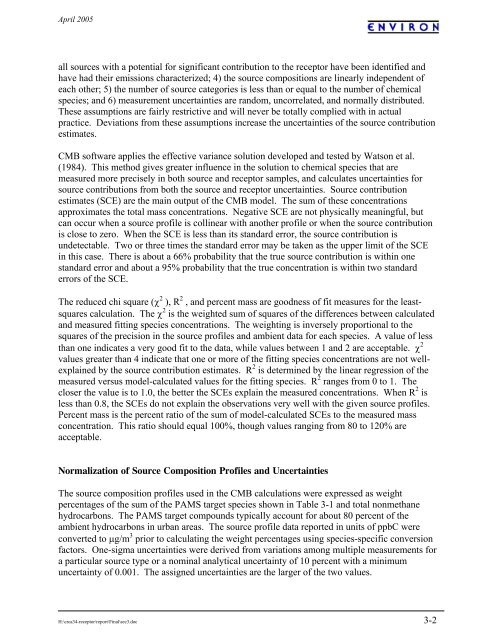CRC Report No. A-34 - Coordinating Research Council
CRC Report No. A-34 - Coordinating Research Council
CRC Report No. A-34 - Coordinating Research Council
Create successful ePaper yourself
Turn your PDF publications into a flip-book with our unique Google optimized e-Paper software.
April 2005<br />
all sources with a potential for significant contribution to the receptor have been identified and<br />
have had their emissions characterized; 4) the source compositions are linearly independent of<br />
each other; 5) the number of source categories is less than or equal to the number of chemical<br />
species; and 6) measurement uncertainties are random, uncorrelated, and normally distributed.<br />
These assumptions are fairly restrictive and will never be totally complied with in actual<br />
practice. Deviations from these assumptions increase the uncertainties of the source contribution<br />
estimates.<br />
CMB software applies the effective variance solution developed and tested by Watson et al.<br />
(1984). This method gives greater influence in the solution to chemical species that are<br />
measured more precisely in both source and receptor samples, and calculates uncertainties for<br />
source contributions from both the source and receptor uncertainties. Source contribution<br />
estimates (SCE) are the main output of the CMB model. The sum of these concentrations<br />
approximates the total mass concentrations. Negative SCE are not physically meaningful, but<br />
can occur when a source profile is collinear with another profile or when the source contribution<br />
is close to zero. When the SCE is less than its standard error, the source contribution is<br />
undetectable. Two or three times the standard error may be taken as the upper limit of the SCE<br />
in this case. There is about a 66% probability that the true source contribution is within one<br />
standard error and about a 95% probability that the true concentration is within two standard<br />
errors of the SCE.<br />
The reduced chi square (χ 2 ), R 2 , and percent mass are goodness of fit measures for the leastsquares<br />
calculation. The χ 2 is the weighted sum of squares of the differences between calculated<br />
and measured fitting species concentrations. The weighting is inversely proportional to the<br />
squares of the precision in the source profiles and ambient data for each species. A value of less<br />
than one indicates a very good fit to the data, while values between 1 and 2 are acceptable. χ 2<br />
values greater than 4 indicate that one or more of the fitting species concentrations are not wellexplained<br />
by the source contribution estimates. R 2 is determined by the linear regression of the<br />
measured versus model-calculated values for the fitting species. R 2 ranges from 0 to 1. The<br />
closer the value is to 1.0, the better the SCEs explain the measured concentrations. When R 2 is<br />
less than 0.8, the SCEs do not explain the observations very well with the given source profiles.<br />
Percent mass is the percent ratio of the sum of model-calculated SCEs to the measured mass<br />
concentration. This ratio should equal 100%, though values ranging from 80 to 120% are<br />
acceptable.<br />
<strong>No</strong>rmalization of Source Composition Profiles and Uncertainties<br />
The source composition profiles used in the CMB calculations were expressed as weight<br />
percentages of the sum of the PAMS target species shown in Table 3-1 and total nonmethane<br />
hydrocarbons. The PAMS target compounds typically account for about 80 percent of the<br />
ambient hydrocarbons in urban areas. The source profile data reported in units of ppbC were<br />
converted to µg/m 3 prior to calculating the weight percentages using species-specific conversion<br />
factors. One-sigma uncertainties were derived from variations among multiple measurements for<br />
a particular source type or a nominal analytical uncertainty of 10 percent with a minimum<br />
uncertainty of 0.001. The assigned uncertainties are the larger of the two values.<br />
H:\crca<strong>34</strong>-receptor\report\Final\sec3.doc 3-2
















